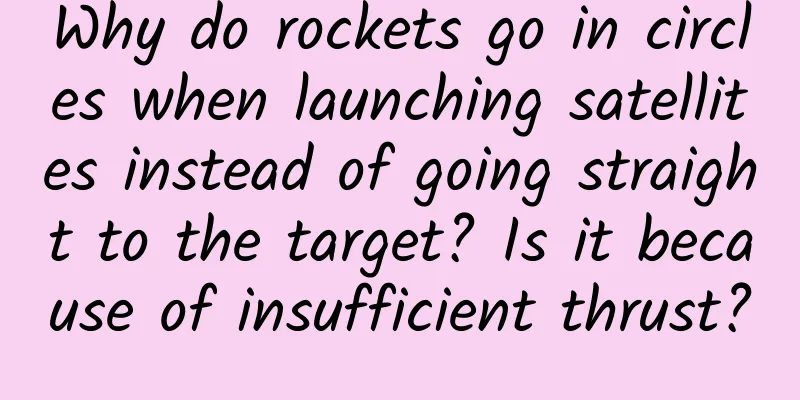Why do rockets go in circles when launching satellites instead of going straight to the target? Is it because of insufficient thrust?

|
Everyone who has attended junior high school knows that the shortest distance between two points is a straight line. However, looking at all the space launches in the world, whether it is launching satellites or manned spacecraft, the launch vehicles have to turn and circle when sending these spacecraft into space. Why is this? Is it because the launch vehicle's thrust is not enough? Take the Long March 5 rocket for example. The thrust of this rocket can send a 14-ton spacecraft to the geosynchronous transfer orbit. If a satellite with a smaller mass is launched, it will certainly be able to be sent to an orbit farther from the ground. But why is it that almost no space launch adopts this "vertical upward" launch method? Regardless of the launch mission, the flight trajectory of the carrier rocket is basically like the picture below. The rocket rises from the ground to high altitude, and the rocket's trajectory will gradually tilt along the way, and finally the flight trajectory is almost parallel to the ground, and then disappears from our field of vision. There are only three possible outcomes when launching a spacecraft vertically upward. 1. The rocket has enough power to directly allow the spacecraft to escape the earth's gravity, and then keep flying until it is captured by the gravity of other celestial bodies. The minimum initial speed required for a spacecraft to escape the earth's gravity is 11.2 kilometers per second (this is called the second cosmic speed). 2. Another possibility is that the spacecraft just flew to the Lagrange point and stopped. The Lagrange point is the gravitational balance point between two celestial bodies. Theoretically, there are five Lagrange points between any two celestial bodies, but usually only two are the most stable. Near the Earth, the closest Earth-Moon Lagrange point is 65,000 kilometers away from the Earth, while the closest Earth-Moon Lagrange point is 1.5 million kilometers away from the Earth. 3. The rocket is not powerful enough and the spacecraft cannot escape the gravity of the earth. Under the influence of the earth's gravitational acceleration, it will eventually fall back to the ground. In most cases, we launch spacecraft that orbit the Earth. If we use this "vertical upward, one-pole-to-the-top" method to launch a spacecraft, even if the thrust of the rocket is strong enough to send the spacecraft to the predetermined orbital height in one go, it will eventually fall under the influence of the Earth's gravity. In order to overcome the influence of the earth's gravity, the spacecraft must be given a tangential velocity to generate centrifugal force to offset the earth's gravity and make the spacecraft move in a circular or elliptical motion around the earth. Therefore, the rocket must turn when it is launched, and the rocket's flight trajectory is also an arc. Because only in this way can a tangential velocity be applied to the spacecraft. In fact, it is also possible for a rocket to send a spacecraft to its destination. If there is no tangential velocity provided by the rocket, then the spacecraft must rely on its own power to generate a tangential velocity. However, this requires carrying a large amount of fuel, which will inevitably increase the mass of the spacecraft. As the mass of the spacecraft increases, the thrust of the launch vehicle must also be increased, and the launch vehicle also needs to consume more fuel. Of course, in addition to saving fuel, this is also because the thrust of existing rockets is not large, and it is difficult to send a spacecraft into a high orbit all at once. Even if this can be done, it is not cost-effective. Spacecraft orbit the Earth in a circle above the Earth, and the orbital plane must pass through the center of the Earth. There are many types of orbits for spacecraft orbiting the Earth. According to the orbital height, it can be divided into low orbit (near earth orbit), medium orbit and high orbit. There is no strict division between high and low orbits. Generally, those with an altitude below 1,000 kilometers are called near earth orbit or low orbit. The higher the orbit, the slower the spacecraft will move; the lower the orbit and the closer it is to the ground, the faster the speed required. If a spacecraft wants to fly close to the sea level without falling, its speed must reach 7.9 kilometers per second (the first cosmic speed), which is also the maximum speed a spacecraft can reach when orbiting the earth. When the orbital altitude is 36,000 kilometers, the spacecraft's operating period is the same as the Earth's rotation period. This orbit is called a geosynchronous orbit. If the inclination of a geosynchronous orbit is zero, the spacecraft flies exactly along the Earth's equator. This orbit is called a geostationary orbit (or geostationary orbit), which is a special case of a geosynchronous orbit and there is only one. According to the orbital inclination, it can be divided into equatorial orbit, polar orbit and inclined orbit. Among them, the equatorial orbit has an inclination of 0 degrees, and the orbital plane coincides with the earth's equatorial plane; the polar orbit has an inclination of 90 degrees, and the orbital plane is perpendicular to the earth's equatorial plane, and the spacecraft will fly over the North and South Poles; and the inclination of the inclined orbit is neither 0 nor 90 degrees. If the spacecraft flies in the direction of the Earth's rotation, it can be divided into direct motion and retrograde motion. In order to cope with the lack of rocket thrust and considering economic factors, most spacecraft are launched into a low-Earth transfer orbit first, and then use the spacecraft's own power to gradually change orbit to a medium-high orbit. If you want to send a spacecraft to a geosynchronous orbit or geostationary orbit 36,000 kilometers from the ground, you must first send the spacecraft to a transfer orbit. The perigee of this transfer orbit is only a few hundred kilometers from the ground, and the apogee is more than 36,000 kilometers. Then, at least two accelerations must be performed at the transfer point to raise the orbital altitude, and then the orbit must be fine-tuned before it can reach the predetermined orbit. The fine-tuning parameters include orbital inclination, orbital altitude, etc. This transfer method is called Hohmann transfer. It makes full use of the gravity of celestial bodies and can save spacecraft fuel to a great extent. The only drawback is that it takes a long time. In fact, there is another reason why the launch vehicle flies obliquely, because the flight orbit of most spacecraft is not located above the launch site. In order to launch to the predetermined orbit, the launch vehicle cannot fly vertically after taking off from the ground. If it is launched along the direction of the earth's rotation, it will save more fuel with the help of the earth's rotation linear velocity. |
>>: Is the constant urge to go to the toilet actually a disease?
Recommend
The gradually disappearing Northeast Internet: Hometown is the way out of the cage
Legend has it that there is a unique genre of wri...
Breaking through the Western technology blockade, her research has made fluorescent lamps light up thousands of households
There has never been a lack of great women on the...
Kuaishou advertising, Kuaishou advertising account establishment, Kuaishou advertising resource location
Kuaishou, a short video social platform, has achi...
Warning: Never put frozen food back into the refrigerator after thawing!
During the Spring Festival holiday, you may have ...
Global Science News | Scientists from many countries emphasize that the new coronavirus is not a "laboratory leak"
· Novel Coronavirus· Scientists from many countri...
Chinese characteristics in the eyes of Japanese mobile game industry insiders: unique application distribution and promotion methods
via:appying If overseas games are to be released ...
A 24-year-old boy fainted after having his teeth extracted and died after a craniotomy! Can wisdom teeth still be extracted?
Recently, #A 24-year-old boy fainted and died aft...
Where are the borders? Dell XPS 13 ultra-thin notebook review
Suning's notebook summer promotion continues ...
How to operate a community in 2020!
“No one speaks in the group, it’s not active at a...
How to place Xiaomi information flow? I summarized the 4-step method of creative optimization that affects CTR
Users are paying more and more attention to the e...
Internet opium: fake orders
[[134460]] Recently, a piece of news about Uber f...
Just observe the bubbles, this article will teach you how to become a wine connoisseur
Author: Deuterium The article comes from the Scie...
Top Community Operator Club: Practical Methods + Traffic + Projects + IP + Tools 9 Major Rights Empowerment [Video Tutorial]
Introduction/The growth path of top community ope...
Store promotion: How to create an effective lottery game?
The lottery gameplay is very attractive to users,...
Fu Lei, "Organizational Methodology: How do organizations undertake strategic changes? 》
Fu Lei's "Organizational Methodology: Ho...









